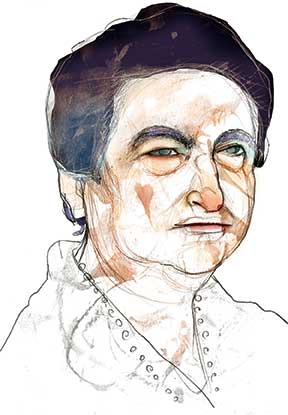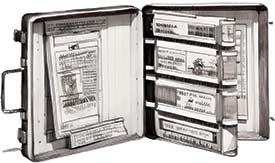Mamata Pandya
What is it that would help lighten the weight of school bags, is portable, makes learning more attractive, teaching to the level of each student, can be used in the dark, supports learning with sounds, can be used in multiple languages, and can be a useful teaching aid for teachers?
Today most school children can easily answer this with the word “tablet”. But this list and this vision of such a teaching-learning device was made over 75 years ago and resulted in an invention called Mechanical Encyclopedia. The inventor was Angela Ruiz Robles – a Spanish school teacher.

Angela’s story is fascinating and inspirational.
Angela Ruiz Robles was born on 28 March 1895, in Villamanin, a municipality in the province of León in Spain. Her father Feiciano Ruiz was a pharmacist and her mother Elena Robles, a housewife. Angela completed her higher education at the teacher training college in León and went on to teach shorthand, typing, and business at the same college from 1915 to 1916. In 1917 she was a teacher and director at the Gilberto Gordón School in Gordón, a town located near the city of León.
In 1918 she accepted a position as teacher in Santa Eugenia de Mandía, a village near Ferrol in Galicia and remained there for the next decade. It is here that she found her true calling as a teacher. She was totally dedicated to her students, giving personal attention to each one; noting those who required special attention. Her work was not confined to the classroom; she visited the homes of her students to provide additional instruction and support. She understood that every child has unique learning abilities, personalities, and insecurities. As her old students recalled: “Doña Angelita, who was known by her first name to all of us, was the perfect teacher. She never treated any student differently and always honoured each individual learner’s needs.” Angela spent 10 years in the village school and was greatly loved and respected.
Angela lost her husband when she was 40, and in 1928 she moved to Ferrol. She needed to teach, but now also to provide for her family. She founded the Elmaca Academy named after her daughters Elena, Maria Elvira, and Carmen. The Academy located in her own home provided classes to those aspiring to join customs, become mail carriers, or telegraph operators, or apply for business management studies. Her academy followed participatory pedagogical methods that were much ahead of their time; and this was reflected in the highest pass rate in the country for her students.
Along with the regular courses, Angela gave free night classes to people with few resources. The Academy also became a social centre. Letters were read to and written for illiterate immigrants; literary gatherings were held; food distribution was organized, and religious processions could be watched from here.
In 1934, she became manager of the Escuela Nacional de Niñasdel Hospicio (National Girls’ School of the Hospice) in Ferrol, which cared for orphaned or abandoned girls. Doña Angelita made sure that the girls got a primary education, musical education, and learned a useful trade so that they could earn and integrate with society.
As Angela continued her teaching and other educational work, she also had to support and bring up her three young girls by herself, but she made time for her own research and writing. Between 1938 and 1946, she wrote and edited about 16 books. She published three of them: Compendium of Castilian Orthography, Castilian Orthography (abbreviated), and Modern Abbreviated Martinian Shorthand – books addressing the conventional Spanish spelling systems. In 1944, Ángela Ruiz started her Scientific-Grammatical Atlas project. Her goal was to teach Spanish grammar and spelling and make Spain better known through Spanish grammar, syntax, morphology, spelling, and phonetics.
Angela Ruiz was also constantly thinking of resources, innovations, and inventions that would help improve the teaching-learning process and spent hours after her daily work exploring and experimenting with such tools. Her aim was simple: “To make teaching easier, to get maximum knowledge with minimum effort.”

It was then that she dreamed of what she described as a “Mechanical Encyclopaedia” which addressed the needs listed in the first paragraph of this article. This book included a vast range of information which was represented in graphic, sound, or textual form. It could be made of waterproof and lightweight materials. It had the possibility of directly incorporating lighting and magnifying glasses.
Her invention consisted of patterned sheets. When you put your finger on them, they lit up and an educational text appeared. For this to happen, she incorporated an electrical circuit that she designed herself.
Angela made a sketch and detailed out her new kind of book which she described as “a mechanical, electrical, and air pressure procedure for reading books.” She was certain that her invention was a valuable educational tool and went to Madrid to find promoters. Her invention was appreciated, but did not result in any funding for her to develop the patent. Angela was disappointed, but undeterred she continued to work on improving her invention.
On 10 April 1962, 10 years after her first attempt, she filed a patent entitled An Apparatus for Various Readings and Writings. That prototype made of zinc and bronze was the Mechanical Encyclopedia. Today this prototype is exhibited at the National Museum of Science and Technology in A Coruñain Spain.
With that physical prototype, she once again undertook the rounds of different ministries in Madrid. Again the story repeated: many pats on the back, but not a single penny. After all she was a woman, and a provincial school teacher, how could her invention be taken seriously? Angela continued her efforts until she was almost 75 years old, but she was unable to develop or distribute her invention.
Today writer and philanthropist Michael Hart is best known as the inventor of the e-book, and in 1971, he created the Gutenberg Project, the first project to make e-books freely available via the internet. Sadly, forgotten in history books is the name of Angela Ruiz Robles, a passionate and dedicated teacher and the original pioneer of the electronic book.
The author worked at the Centre for Environment Education in Ahmedabad for over three decades, where she was engaged in instructional design for educators and children. She is now an independent consultant, editor, writer, translator, storyteller and blogger. She can be reached at mamata.pandya@gmail.com.
